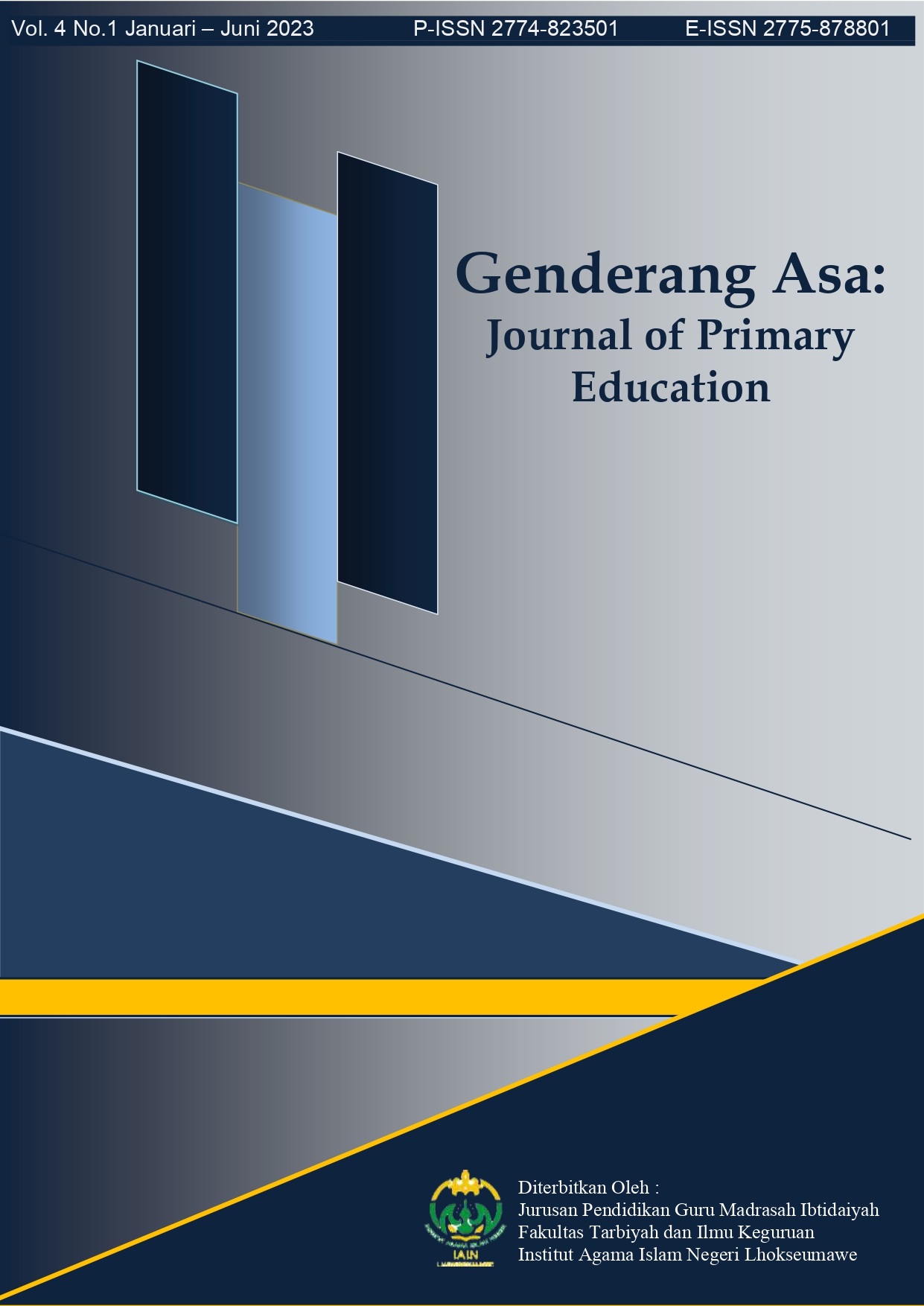The Understanding of Shirah Nabawiyah Santri TPA Baitul Izzah Mosque, Kuta Blang, Bireuen Regency Through Storytelling Methods Assisted by Islamic Comics
Main Article Content
Muthmainnah Muhammad
Rasulullah SAW is the main example of the Islamic community. Planting his example should be done from an early age through Shirah Nabawiyah. In Shirah Nabawiyah there are many historical values in the form of stories about past events both during the time of Rasulullah SAW and after he died. The length of the stories of the Prophet's life will be very difficult for students to understand if only by reading. Therefore we need a method that is most appropriate to tell it so that students can understand it deeply and efficiently. This method is a storytelling method with the help of Islamic comic media. This is the object of this research. The sample of this research is Santri TPA Baitul Izzah Mosque, Kec. Krueng Panjoe, Kab. Bireuen which amounted to 30 people. The results of this study indicate that students find it easier to understand Shirah Nabawiyah when conveyed through the application of the storytelling method with the help of Islamic comic media. It can be concluded that students' understanding can be identified by the emergence of several cognitive indicators where students are able to interpret, give examples, classify, explain, summarize, and conclude.
Agustin, R. M. (2018). Nilai-Nilai Akhlak Dalam Seri Komik Islami Dunia Sementara Tertawalah Seperlunya (Analisis Semiotik). Al-Mishbah: Jurnal Ilmu Dakwah Dan Komunikasi, 14(1). https://doi.org/10.24239/al-mishbah.vol14.iss1.107
Ardian, Y., Arrozi, F., & Aftori, R. (2021). Internalisasi Budaya Senyum, Sapa, Salam, Sopan, Santun (5S) dalam Pola Kepemimpinan Kiai untuk Membentuk Budaya Ta’ẓīm Santri. ITQAN: Jurnal Ilmu-Ilmu Kependidikan, 12(2), 289–298. https://doi.org/10.47766/itqan.v12i2.278
Damopolii, I., & Rahman, S. R. (2019). The Effect of STAD Learning Model and Science Comics on Cognitive Students Achievement. Journal of Physics: Conference Series, 1157, 022008. https://doi.org/10.1088/1742-6596/1157/2/022008
Fatimah, S., Yuberti, Y., & Ayu, S. M. (2021). Evaluation of the Spiritual Extracurricular Program in Madrasa. Journal of Advanced Islamic Educational Management, 1(1), 19–34. https://doi.org/10.24042/jaiem.v1i1.9210
Hikmah, N. (2021). Strategi Pendidikan Karakter Pada Anak Dalam Setting Keluarga di Era Disrupsi. Genderang Asa: Journal of Primary Education, 2(1), 12–24. https://doi.org/10.47766/ga.v2i1.1351
Lyansari, K. N. (2019). Belajar Islam Melalui Literatur Visual: Pembentukan Identitas Moderat Anak Muslim Milenial. Al-Balagh:Jurnal Dakwah Dan Komunikasi, 4(2), 293–316. https://doi.org/10.22515/balagh.v4i2.1821
Mawangir, M. (2018). Nilai-Nilai Pendidikan Karakter Perspektif Tafsir Al-Mishbah Karya Muhammad Quraish Shihab. Tadrib: Jurnal Pendidikan Agama Islam, 4(1), 163–182. https://doi.org/10.19109/Tadrib.v4i1.1917
Miftah Nurul Annisa, Ade Wiliah, N. R. (2020). Pentingnya Pendidikan Karakter pada Anak Sekolah Dasar di Zaman Serba Digital. Jurnal Pendidikan Dan Sains, 2(1), 35–48.
Nisak, N. M., Arifin, M. B. U. B., Fahyuni, E. F., & Rahmawati, I. M. (2021). The Development of Comic Formatted Fiqh Textbook for Islamic Elementary School. European Journal of Education Studies, 8(1).
Noor, T. R. (2020). Mengembangkan Jiwa Keagamaan Anak (Perspektif Pendidikan Islam dan Perkembangan Anak Usia Dini). KUTTAB, 4(2). https://doi.org/10.30736/ktb.v4i2.269
Nurhidayatuloh, A. T., Feronika, R., & Khoirunnisa, R. (2023). Pengembangan di Co-Book ( Digital Comic dan E-Book ) Kisah Hijrah Rasulullah SAW sebagai Media Pembelajaran PAI di SD. Jurnal Pendidikan Tambusai, 7(1), 4280–4288.
Nurjayanti, D., Pudyaningtyas, A. R., & Dewi, N. K. (2020). Penerapan Program Taman Pendidikan Alquran (Tpa) Untuk Anak Usia Dini. Kumara Cendekia, 8(2), 183. https://doi.org/10.20961/kc.v8i2.34631
Rahmat, A. (2021). Internalisasi Nilai - Nilai Akhlak Melalui Pentas Drama di MIS Al-Istiqamah Aceh Besar. Genderang Asa: Journal of Primary Education, 2(2), 43–51. https://doi.org/10.47766/ga.v2i2.151
Rofiki, M., Nadrah, N., Hasanudin, C., Suttrisno, S., Ananda, R., & Siahaan, K. W. A. (2022). Hadith Learning Strategies in Early Childhood Education. Jurnal Obsesi : Jurnal Pendidikan Anak Usia Dini, 6(6), 7141–7152. https://doi.org/10.31004/obsesi.v6i6.3373
Somad, M. A. (2021). Pentingnya Pendidikan Agama Islam dalam Membentuk Karakter Anak. QALAMUNA: Jurnal Pendidikan, Sosial, Dan Agama, 13(2), 171–186. https://doi.org/10.37680/qalamuna.v13i2.882
Syaepul Bahtiar, M., Amri Syafri, U., & Hardiyanto, B. (2021). Pendidikan Karakter pada Pembelajaran Sirah Nabawiyah dalam Kitab Khulashoh Nurul Yaqin. Rayah Al-Islam, 5(02), 255–267. https://doi.org/10.37274/rais.v5i02.460
Syamsudin, A. (2015). Pengembangan Nilai-Nilai Agama dan Moral pada Anak Usia Dini. Jurnal Pendidikan Anak, 1(2). https://doi.org/10.21831/jpa.v1i2.3018
Thohir, A. (2014). Sirah Nabawiyah: Nabi Muhammad Saw dalam Kajian Ilmu Sosial Humaniora. Nuansacendekia.
Vina, T., & Amelia, W. (2023). Increasing Mathematics Learning Outcomes Through Comic Media Multiliteration. Educativo: Jurnal Pendidikan, 2(1), 133–143. https://doi.org/10.56248/educativo.v2i1.115



